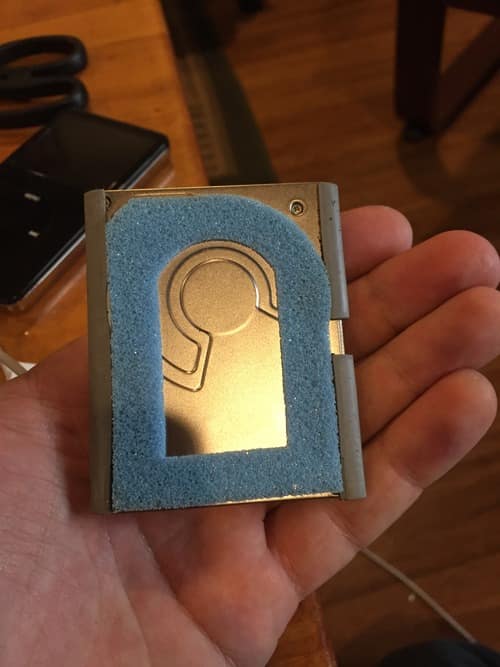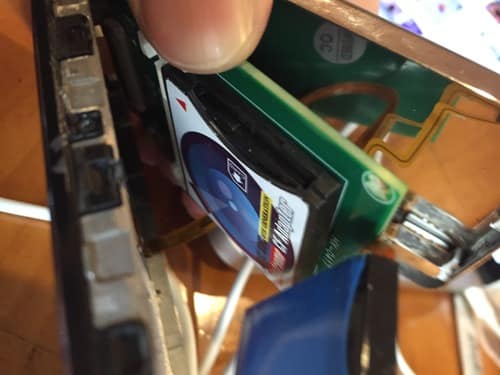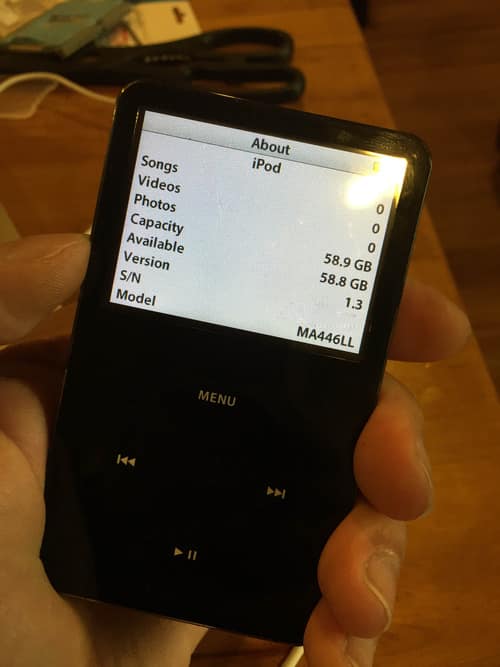The 30 GB iPod Classic that grew up to 64 GB
Forward
I wrote this back in October, after buying an iPod classic replace my missing 120 GB iPod classic. I finally edited and posted it on December 4th, 2014, and since then there’s been a run on the used iPod market.
The hackable iPod
Ever since the iPod Minis, the iPods have been fairly hackable. After all, the iPod is essentially a portable hard drive that happens to have an ultra light weight operating system and screen attached to it.
What really prohibited most hackers was that the economics didn’t make much sense when CompactFlash card with only a quarter of the storage, cost more than an entire iPod. Most iPod hacking thus was limited to the iPod Mini faction, (where replacing 4 GB Hard drives with equal or greater sized CompactFlash cards was affordable) or loading custom firmware like Rockbox for Flac compatibility (before Apple offered its own lossless alternative).

The end of an era
Quietly, Apple killed the iPod classic after the iPhone 6 announcement and all the remaining inventory was liquidated at an alarming rate. Boxed iPod have shot up in price on Ebay and Amazon.com beyond their MSRP.
Wanting to get an iPod before they’re gone forever, I settled on a 3rd party refurbished iPod 30 GB on Amazon.com, sporting a new faceplate, backplate and battery for $100.
Why not get an iPod touch you ask?
Simple: Storage, Cost, and retro appeal. To this day, there isn’t a media player better at playing music. And iPod can be operated without even looking at the screen (Try skipping tracks or pausing a touch screen blinded folded if you don’t believe me). iTunes Match + Siri certainly works well but with data throttling and a frequency for driving places without 4G, means local storage still wins out.
Shopping list
Hacking an iPod doesn’t require much in the way of specialized tools, there’s a variety of tools out there. Years ago, I replaced a battery in a friend’s iPod, which came with a cheap plastic hook. Since then there’s been a small cottage economy of iPod replacement parts and tools.
The iPods 5G+ all use ZIF (Zero Insertion Force) based HDs, which is a quasi standard for ATA variants.
So in addition to my iPod, my parents list included
- Newer Technology iSesamo - Tool for easily opening iPod
- Micro SATA Cables - CF Card to 1.8 inch ZIF Adapter - An adapter suited for converting ZIF to CompactFlash
- SD-CF II: SD to CF Type II Adapter - A CompactFlash to SD card
- 64 GB SD Card to hold me until 256 GB cards drop in price.
CompactFlash cards for years have had SD card beat on storage and price but in the last two years, SD Cards have come a long ways, with the fastest cards at 250 MB/s write speeds. Impressive but it is still half the speed of a Lexar 3400x card with an incredible 500 MB/s write speed. However, the price differences between CF and SD are quite profound, with CF cards often costing 2x-3x as much as the SD card. Since I’m not recording 4k video, a moderate SD card will suffice.
Popping open the iPod is easily the most difficult part of the entire procedure (although my old 80 GB iPod, bless its little heart could be squeezed open by hand). Prying it open, I marred the case edge in a spot (barely noticeable). You may want to check out more expensive iPod opening tools if you’re concerned.
Once open, removing the HDD took a little more force than I expected from a “Zero Insertion Force” tool, but it only took a minute to connect the CF card.

Yanking out the iPod HDD requires being careful not to wreck the ZIF connector. Once done its a matter of simply plugging in the ZIF adapter with CF Card + SD Card.

Snapping it back together is a little tricky as the battery free floats in the iPod.
Once all the parts are installed, I plugged my iPod into my computer and booted it up. The iPod went into factory restore mode, to which iTunes automatically reloaded the OS.

Now the waiting game begins. 128 GB cards as of writing this are floating below $50, whereas 256 GB are $100.
Things observed:
The battery life sucks but I didn’t test the iPod before swapping media types. I’m curious if the iPod battery wasn’t new.
There’s no speed increase between skipping songs. There may be a small speed penalty for using the CF to SD adapter negating much gains. Also the iPod uses massive caching to avoid skipping so its quite likely that the speed gains aren’t felt partly due to the OS trying to compensate for its spinning parts.
The iPod seems to run fine otherwise, it doesn’t have the days of charge than I’m used to so I may end up buying another battery.